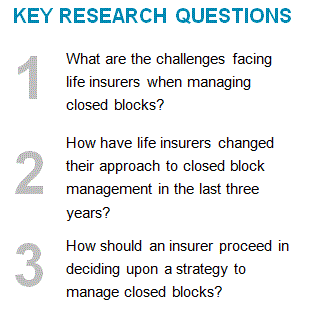Managing Life Insurance Closed Blocks: A 2016 Update
Abstract
 |
Factors such as low investment returns, management distraction, and increasingly higher costs to administer shrinking blocks are leading insurers to question what they should do about products that they no longer consider strategic. This is Celent’s second look at closed blocks in life insurance. Since our original report, US insurers have not closed blocks at the pace they did prior to our 2012 report. This report will update the 2012 analysis. It will also update the exit strategies an insurer may take in regards to the administration of these closed books of business as they turn into “run-off” businesses. |
Closed blocks (or books) are defined as policies that are no longer sold actively, but are accounted on the financial statements of a life carrier as premium-paying policies. The long-term run of life insurance makes it hard for insurers to see the immediate need for a long-term closed block strategy. A strategy of handling closed blocks internally to contain costs and manage the run-off makes sense for closed blocks that reside on the same policy administration systems to the open blocks. However, as insurers upgrade their policy administrations systems, implement digital strategies, and look to rationalize systems, the cost administering a diminishing closed block increases as does the risk of technology obsolescence.
“Each time an insurer opts to close a block of business it is faced with management and administrative challenges. For the most part, closed blocks are considered a drain on the company's capital, but there are many other challenges that the insurer must overcome or at least mitigate,” says Karen Monks, an analyst with Celent’s North American Insurance practice and coauthor of the report. “It finally seems that these challenges are forcing insurers to make decisions on their closed blocks.”
“Since 2012 the outward view shows that insurers are divesting their closed block businesses, specifically selling them to reinsurers,” says Jamie Macgregor, senior vice president of Celent’s Insurance practice and coauthor of the report. “However, given that only a dozen or so deals took place in the last three years, Celent believes the dominant strategy remains an internal run-off supported by a reinsurance deal.”
This 16-page report contains one table and three figures.

